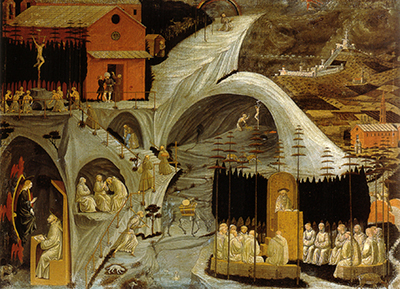Also known as Scenes from the lives of the Saints and Monks, or The Life of the Holy Fathers, The Thebaid by Paolo Uccello was originally commissioned by the monastery San Giorgio alla Costa in Florence and was completed in around 1460.
The name Thebaid itself refers to a desert region near Thebes in Egypt, known for its hermits in early Christianity. The scene depicts a rocky landscape punctuated with forests and gaping caves and peopled with both animals and religious images. Images such as Frances of Assissi receiving stigmata, Jerome adoring a crucifix, Bernard of Clairvaux encountering a vision of the Virgin Mary, and Benedict of Nursia preaching dominate the theme of the painting. There are also numerous scenes of a monastic lifestyle included in the piece, although these are notably in the style of 15th century Florence, rather than those that would have been found in the times of early Christianity.
The painting seems to be a celebration of the monastic life in general. This masterpiece is now to be found in the Galleria Del Accademia, still in Florence. The Thebaid is painted using tempera on canvas. Tempera was commonly used in Italy up to the sixteenth century and consisted of pigments mixed with a water soluble medium, such as egg yolks, which were glutinous and thereby allowed it to stick to the canvas. The paint dried quickly, with a transparency that allowed for multiple layers of paint to be applied.
Artists built up the colour in this manner until the desired matt finish was acquired. The results were less vibrant than that of oil paint, resulting in a pastel effect that was duller than the vibrancy expected of more modern medium. The finish tends towards washed out colours, but the advantage to this method is the long life of the paint, which does not fade or discolour as do other pigments used in this era. Evidence for the lasting paint lies in painting from Egypt still colouful now, even after millennia. This method of painting was prolific in Italy until around 1500, when oil became the preferred paint used by artists.




